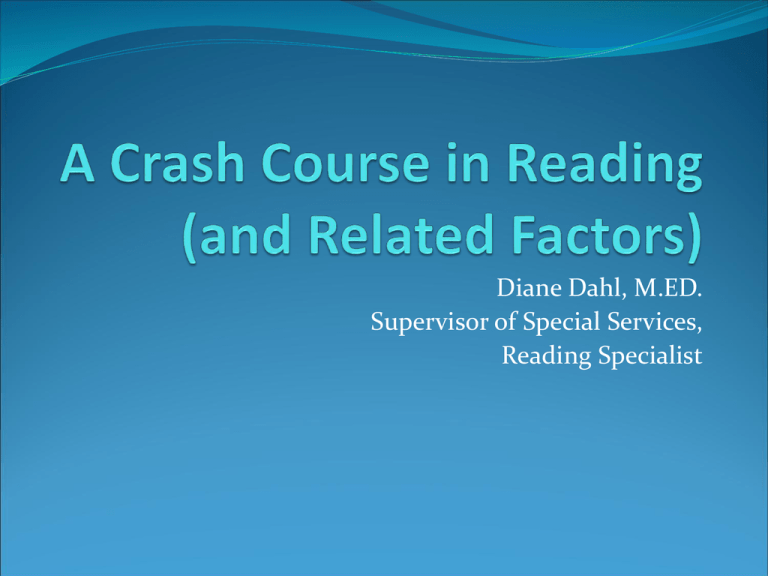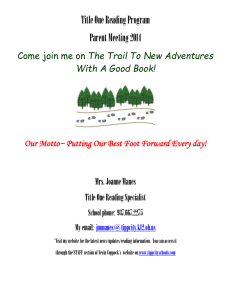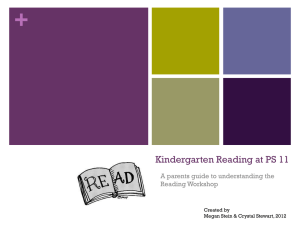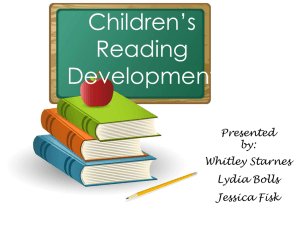A Crash Course in Reading
advertisement

Diane Dahl, M.ED. Supervisor of Special Services, Reading Specialist Ultimate goal of reading instruction The ultimate goal of reading instruction is for children to become sufficiently fluent to understand what they read. To read grade-level material with comprehension To motivate students to want to read To prepare students to be successful in college and career Scary statistics Our research shows that, under current conditions, the level of academic achievement that students attain by eighth grade has a larger impact on their college and career readiness by the time they graduate from high school than anything that happens academically in high school. From: The Forgotten Middle (ACT, 2008) Adults with lower levels of literacy and education are more likely than adults with higher levels of literacy and education to be unemployed or to earn an income that falls below the poverty level (Kutner et al., 2007). Furthermore, adults without a high school diploma or postsecondary education are more likely to be incarcerated than adults with higher levels of education (Harlow, 2003). From: Reading on Grade Level in Third Grade: How Is It Related to High School Performance and College Enrollment? (2010) Average annual 2008 earnings of workers 18 and older without a high school diploma- $21,023 with a high school diploma- $31,283 with a bachelor’s degree- $58,613 with an advanced degree- $83,144 From: Back to School (U.S. Dept. of Commerce, 2010) Reading is a complex skill/process Requires many sub-skills Requires coordination of many simultaneous processes Failure of any one of these skills or processes results in some type or degree of reading difficulty The Many Strands that are Woven into Skilled Reading (Scarborough, 2001) LANGUAGE COMPREHENSION BACKGROUND KNOWLEDGE VOCABULARY KNOWLEDGE LANGUAGE STRUCTURES VERBAL REASONING Skilled Readingfluent coordination SKILLED READING: of word reading and fluent execution and comprehension coordination of word recognition and text processes comprehension. LITERACY KNOWLEDGE WORD RECOGNITION PHON. AWARENESS DECODING (and SPELLING) SIGHT RECOGNITION Reading is a multifaceted skill, gradually acquired over years of instruction and practice. Process of skill acquisition Novice level Conscious processing Time-intensive Expert level Mostly unconscious processing- automaticity Much faster How memory works You sense something (see, hear, smell, etc.) That piece of information stays in immediate memory for 15-30 seconds. If rehearsed immediately, info moves to short term memory (15-30 minutes) If the info is elaborated upon or processed, it can move to long-term memory. Info should be reviewed 10/24/7 for true retention Motivation and student selfefficacy Factors that affect motivation Intrinsic vs. extrinsic motivation Self-efficacy what a person believes they are capable of doing Attribution theory (Weiner, 1980, 1992) • An individual’s success at a task can be viewed as… – Internal or external (factors in us vs. in the environment) – Stable or unstable (directly related to our behavior) – Controllable or uncontrollable (changeable or not) • …and can be attributed to one of four factors – Ability (internal, stable, no personal control) – Task difficulty (external, stable, no personal control) – Effort (internal, unstable, learner-controlled) – Luck (external, unstable, no personal control) Attribution theory (cont.) How people attribute their success or failure will determine future behavior in regard to this type of task People will attribute success or failure to whatever factor enables them to retain a positive self-image. It is best for students to believe that their behavior and effort (not external factors) leads to success or failure. How is reading typically acquired? NOT a natural process- requires instruction FIVE PILLARS OF READING INSTRUCTION Phonics Fluency Vocabulary Comprehension Phonemic awareness Phonological/Phonemic awareness • Phonological awareness- Overall understanding that oral speech can be broken down into smaller units- sentences, words, syllables, individual sounds (phonemes) Phonemic awarenessThe understanding that words are composed of individual sounds (phonemes) which can be manipulated to create new words. Phonics The relationship between the spoken sounds (phonemes) and the written letters (graphemes) that represent those sounds. Used in reading (decoding) and spelling (encoding). A child’s phonics knowledge can be assessed by analyzing his errors in reading and spelling- random errors are rare. Fluency • Speed, accuracy, and prosody (phrasing) while reading • Automatic word recognition and decoding leaves cognitive resources for comprehension • Miller’s number of items (7+/- 2) in working memory • Reduces the time required to read a text, decreasing fatigue and frustration • Benchmark fluency rates by grade Oral Reading Fluency (ORF) Target Rate Norms Developed and reported by: Hasbrouck, J., & Tindal, G. (2006) ORF Norms: A valuable assessment tool for reading teachers. The Reading Teacher, 59(7), 636–644. Hasbrouck, J., & Tindal, G. (2005) Oral Reading Fluency Normshttp://www.brtproje cts.org/publications/techn ical-reports. Oral Reading Fluency (ORF) Target Rate Norms Fall (WCPM) Winter (WCPM) Spring (WCPM) 1 2 3 4 30-60 50-90 70-110 10-30 50-80 70-100 80-120 30-60 70-100 80-110 100-140 5 6 7 8 80-120 100-140 110-150 120-160 100-140 110-150 120-160 130-170 110-150 120-160 130-170 140-180 Grade Source: Adapted from “AIMSweb: Charting the Path to Literacy,” 2003, Edformation, Inc. Available atwww.aimsweb.com/norms/reading_fluency.htm. Data are also adapted from “Curriculum-Based Oral Reading Fluency Norms for Students in Grades 2 Through 5,” by J. E. Hasbrouck and G. Tindal, 1992, Teaching Exceptional Children, 24, pp. 41-44. Vocabulary • Most vocabulary is learned orally through conversation and read-alouds • Can be learned through reading, but more difficult (dependent on ability and text density) • Must be taught and reinforced repeatedly • Be aware of idioms and culturally American concepts when working with ELL’s (drive-in, cut-offs, gonna, wanna, etc.) The Effects of Weaknesses in Oral Language on Reading Growth (Hirsch, 1996) Reading Age Level 16 15 High Oral Language in 14 Kindergarten 13 5.2 years difference 12 11 Low Oral Language 10 in Kindergarten 9 8 7 6 5 5 6 7 8 9 10 11 12 Chronological Age 13 14 15 16 Comprehension • Strategies should be taught orally while students are still learning to read fluently. • Listening comprehension does not replace reading comprehension • Be aware of idioms and culturally American practices/schema when working with ELL’s (birthday parties, Field Day, Mischief Night) • Be cautious about interpreting accurate read-aloud as comprehension. Require students to explain or summarize to demonstrate comprehension Skilled beginning reading requires… Automatic sight-word recognition Automatic or fluent decoding of non-sight words Many poor comprehenders really lack one of the above skills- if oral comprehension is not a problem, it’s probably not a comprehension issue. High-frequency words (sight words) Comprise at least 60-70% of all text. Automatic recognition is required for fluent reading. Some decodable, others not Require repeated exposures to master Incidental exposures vs. intense, concentrated exposures Make sure each exposure is paired with the CORRECT pronunciation- practice makes permanent Several lists- Dolch, Fry, others. Teaching sight words Student needs to accrue the “magic number” of exposures, paired with correct pronunciation to cement the word in long-term memory In isolation until automaticity is reachedflashcard procedure If student has letter-sound knowledge, this should happen more quickly. Daily multiple opportunities to read aloud should reinforce current sight words Other ways of teaching sight words quickly Phonic skills acquisition sequence Single consonant sounds Consonant blends ((bl, cr, st, etc.) Consonant digraphs (ch, sh, th, wh) Short-vowel sounds Long- vowel patterns R-controlled vowel sounds “Weird” vowel sounds (vowel digraphs and diphthongs) (ow, oy, oo, etc.) Phonics assessment and instruction Assessment Informal phonics inventory (Stahl)- others? Frequency- end of each MP Analyze errors to determine starting point Instruction Goal is MASTERY- 90% or better to move on Accuracy then speed (fluency) Accountability and documentation So….. How do we improve student reading scores???? What Really Matters for Struggling Readers (Allington, 2012) 1. Kids need to read a lot 2. Kids need books they can read 3. Kids need to learn to read fluently 4. Kids need to develop thoughtful literacy. 1. Kids need to read a lot John Guthrie suggests that increased practice results in increased proficiency. In order to accelerate struggling readers, they need more practice. The problem is that struggling 4th graders may need 3-5 hours a day of successful reading practice. Reading Volume of Fifth-Grade Students of Different Levels of Achievement (Based on In and Out of School Reading Logs) Achievement Minutes of Words per Percentile Reading Year per Day 90th 40.4 2,357,000 50th 12.9 601,000 10th 1.6 51,000 2. Kids need books they can read. •Reader-text mismatch causes frustration. •Text choice- 95% accuracy= just right (5 finger rule) •Student choice enhances motivation •Multiple sources of leveled books DRA book levels Based on word count, text complexity, sentence length Essential for teachers to understand Students should be able to read multiple books FLUENTLY at a level before he is assessed and moved up. Assessment levels correspond to text levels DRA book levels Based on word count, text complexity, sentence length Essential for teachers to understand Students should be able to read multiple books FLUENTLY at a level before he is assessed and moved up. Assessment levels correspond to text levels Stages of book levels Repeated, patterned, memorized books with picture support (DRA A-2) Books containing only sight words with picture support (DRA 3-6) Books containing mostly sight words, but requiring decoding of short and long-vowel words (DRA 8-14) Books with sight words, requiring decoding of short, long, and r-controlled vowel words, diminishing picture support (DRA 16-24) Books with sight words, requiring decoding of all simple vowel patterns, plus decoding of multi-syllable words, little picture support. (DRA 28+) DRA levels 1-16 DRA level Word count Dolch words (# and %) Short/long decodable words Total 1 16 12 (75%) 3 (19%) 15/16 94% 2 36 30 (83%) 3 8%) 33/36 92% 3 46 34 (74%) 1 (2%) 35/46 76% 4 53 40 (75%) 7 (13%) 47/53 88% 6 71 47 (66%) 12 (17%) 59/71 83% 8 86 52 (60%) 30 (35%) 82/86 95% 10 134 82 (61%) 15 (11%) 97/134 72% 12 137 65 (48%) 19 (14%) 84/137 61% 14 203 130 (64%) 9 (4%) 139/203 68% 16 266 164 (62%) 30 (11%) 194/266 73% 2-1 Reader (random story) 653 104 (53%) 35 (18%) 139/196 71% 3-1 Reader (random story) 578 367 (63%) 114 (20%) 481/578 83% Book leveling practice 3. Kids need to learn to read fluently. •Enhances comprehension and viceversa •Shortens task-completion time •Increases student motivation to read Struggling readers are…. •more likely to read material too difficult for them. •asked to read aloud more. •interrupted more often and quickly. •more likely to wait for prompts. •more likely to be told to sound it out! …while better readers… read books at their level. are asked to read silently. are expected to self-monitor and correct. are only interrupted at the end of a waiting period. are asked to reread and cross-check, not to sound out! 4. Kids need to develop thoughtful literacy. No more “read, remember, and recite” (p.129) Conversation and connections Summarize, analyze, synthesize, evaluate Vocabulary instruction Literate conversations Conclusions









